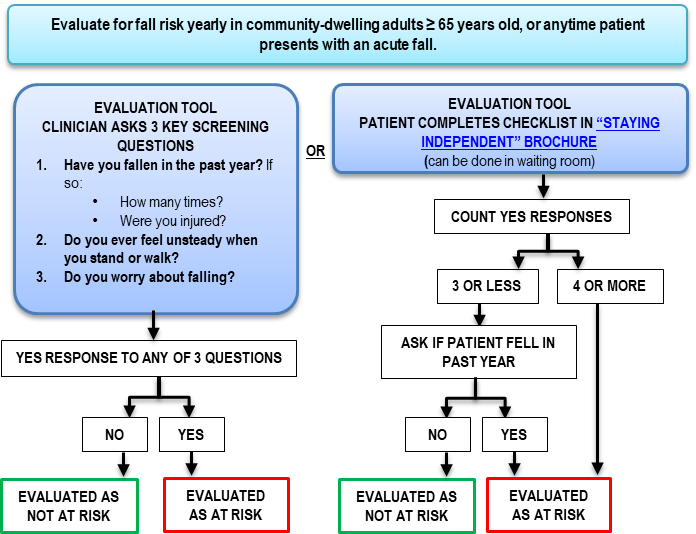Some Known Questions About Dementia Fall Risk.
How Dementia Fall Risk can Save You Time, Stress, and Money.
Table of ContentsOur Dementia Fall Risk IdeasSome Known Details About Dementia Fall Risk The Best Strategy To Use For Dementia Fall RiskNot known Incorrect Statements About Dementia Fall Risk
A loss threat analysis checks to see just how likely it is that you will drop. The assessment typically includes: This includes a series of questions about your general wellness and if you've had previous falls or problems with balance, standing, and/or strolling.STEADI consists of testing, analyzing, and treatment. Interventions are suggestions that might lower your danger of falling. STEADI includes three steps: you for your danger of falling for your danger factors that can be enhanced to attempt to prevent falls (as an example, balance issues, impaired vision) to minimize your danger of falling by utilizing efficient strategies (for instance, giving education and sources), you may be asked numerous inquiries consisting of: Have you fallen in the past year? Do you feel unsteady when standing or walking? Are you bothered with dropping?, your service provider will evaluate your stamina, equilibrium, and stride, using the following fall assessment devices: This test checks your stride.
If it takes you 12 seconds or more, it might indicate you are at higher risk for an autumn. This test checks toughness and equilibrium.
The positions will certainly obtain tougher as you go. Stand with your feet side-by-side. Relocate one foot midway ahead, so the instep is touching the big toe of your various other foot. Move one foot completely in front of the various other, so the toes are touching the heel of your other foot.
The Greatest Guide To Dementia Fall Risk
Most drops take place as a result of numerous adding elements; for that reason, handling the danger of dropping starts with identifying the elements that contribute to fall threat - Dementia Fall Risk. Several of one of the most appropriate risk elements consist of: History of prior fallsChronic clinical conditionsAcute illnessImpaired gait and equilibrium, reduced extremity weaknessCognitive impairmentChanges in visionCertain risky drugs and polypharmacyEnvironmental variables can likewise raise the threat for falls, including: Insufficient lightingUneven or damaged flooringWet or unsafe floorsMissing or damaged handrails and order barsDamaged or improperly equipped devices, such as beds, wheelchairs, or walkersImproper use of assistive devicesInadequate guidance of the people staying in the NF, consisting of those who show aggressive behaviorsA effective loss threat monitoring program needs a thorough professional analysis, with input from all members of the interdisciplinary team

The treatment plan need to additionally include treatments that are system-based, such as those that advertise a risk-free environment (suitable lights, hand rails, get hold of bars, etc). The efficiency of the interventions should be assessed periodically, and the care plan modified as needed to reflect modifications in the autumn danger evaluation. Implementing a fall threat monitoring system using evidence-based ideal method can reduce the prevalence of falls in the NF, while restricting the possibility for fall-related injuries.
The Basic Principles Of Dementia Fall Risk
The AGS/BGS standard advises screening all adults aged 65 years and older for fall threat annually. This screening includes asking clients whether they have actually fallen 2 or even more times in the previous year or sought clinical focus for a fall, or, if they have not dropped, whether they feel unstable when strolling.
Individuals who have fallen as soon as without injury must have their balance and gait evaluated; those with gait or balance irregularities should receive additional assessment. A background of 1 loss without injury and without gait or equilibrium problems does not require additional assessment past ongoing annual loss danger testing. Dementia Fall Risk. A fall risk evaluation is needed as component of the Welcome to Medicare exam

The Best Strategy To Use For Dementia Fall Risk
Documenting a falls history is one of the top quality indications for loss avoidance and administration. Psychoactive medicines in particular are independent forecasters of falls.
Postural hypotension can usually be minimized by decreasing the dosage of blood pressurelowering medicines and/or stopping medicines that have orthostatic hypotension as an adverse effects. Use of above-the-knee support hose and resting with the head of the bed elevated may additionally reduce postural decreases in blood stress. The advisable components of a fall-focused physical evaluation are received Box 1.

A pull time more than or equivalent to 12 seconds suggests high autumn danger. The 30-Second Chair Stand test evaluates reduced extremity toughness and balance. Being unable to stand up from a chair of knee height without utilizing one's arms indicates raised loss danger. The 4-Stage Balance test evaluates fixed balance by having the individual stand in 4 placements, each considerably a lot more challenging.